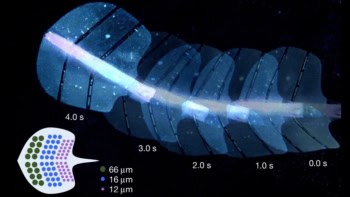
Quantum physics could come to the aid of medical science thanks to a new technique for identifying DNA that utilizes the quantum effect of tunnelling. The method, developed by physicists in the US, will enable users to read genetic codes directly by studying DNA with a scanning tunnelling microscope (STM). This new approach could be developed into a low cost commercial technique for sequencing DNA, say the researchers.
Unlocking the secret of the human genome in 2003 involved more than a decade’s hard graft at a cost of more than $1 bn. The technology that made it possible is known informally as the “shotgun approach” because it involves replicating a strand of DNA millions of times before blasting the replicates into tiny fragments. Computers are then used to piece together a full genome — the genetic profile of a given organism — by matching up overlapping base patterns amongst the DNA shards.
In more recent times the sequencing community has been on the lookout for cheaper, faster and more reliable technologies. This latest effort sees Stuart Lindsay and his colleagues at Arizona State University employ an unusual tool from the world of quantum physics. The physicists exploit the fact that each individual base in DNA has a unique effect on the tunnelling current of a scanning tunnelling microscope (STM).
“This application is very appealing, since tunnelling-based detection has the high spatial resolution to detect individual bases one at a time,” said Tim Albrecht a molecular electronics researcher at Imperial College.
Dangling DNA as bait
An STM involves placing a tiny metal tip very near to a surface of interest and applying a voltage between the surface and tip. Quantum mechanics enables a portion of electrons to tunnel across the gap that, under classical mechanics, they would have insufficient energy to cross. The tip is scanned with great precision across the surface and an image is generated by measuring the current of electrons that tunnel between tip and surface.
DNA’s double helical structure is interspersed with “ladder rungs” which combine the four nucleotide bases — adenine (A), thymine (T), cytosine (C) and guanine (G). These bases exist in DNA in pairs with A pairing only with T, and C pairing only with G. The specific sequence of base pairs in DNA — in the millions for complex organisms — acts as an instruction manual for organisms to build their own bodies.
Key to this new DNA reading technique is the fact that the strength of these bonds differ; A-T pairs are held by two hydrogen bonds, whereas C-G pairs by three hydrogen bonds. Lindsay and his colleagues attach a particular base to the end of an STM and “dangle” it over a sample of DNA. The tip will only bond to the DNA if it is directly above its complementary base. As a result, the tunnelling current fluctuates as the STM tip passes along the sample.
Presenting their findings in Nature Nanotechnology, Lindsay and his collaborators determined that a pattern in the STM image represents a composite of 10 molecules at a time, with the tunnelling currents providing a sort of average stickiness of the hydrogen-bonded pairs.
Getting up to speed
“The basic measurement of DNA base paring electronically has been possible for more than a year, but it has taken to now to understand the mechanism quantitatively,” Lindsay told physicsworld.com.
In moving towards a commercial sequencing technique the next stage is to refine the technique to distinguish between individual bases in a sequence.
“It is an interesting work that elucidates the role of hydrogen bonding to a conducting probe. By itself though it is not a sequencing technique yet,” said Henk Postma , a nano-scale applications researcher at California State University.
Another challenge is that sequencing techniques need to be performed very quickly and the read length — the length of DNA material that can be scanned in one time — needs to be maximized. Some researchers think that this new approach will always be limited by its speed.
“STM-based processes are essentially slow and not cost-effective,” said Changgu Lee a mechanical engineer at Colombia University. “Perhaps the biggest obstacle or challenge for beating conventional techniques will be developing a multiprobe technique — but that seems to be a long way off.”



